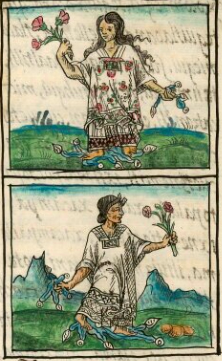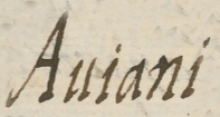ahuiani (FCbk10f39v)
This iconographic example, featuring what Western society refers to as a prostitute (and, in Nahuatl, ahuiani, ahuilnenqui, or cihuatlahueliloqui), is included in this digital collection for the purpose of making comparisons with related hieroglyphs. The term selected for this example comes from two pages prior to the image in the Digital Florentine Codex. There is no gloss, per se. This example shows a frontal view of a standing woman, wearing a flowery huipilli with an elaborate lower border design and an elaborate chest patch. Her skirt (cueitl), likewise, has an elaborate pattern at the bottom, in red and black checks. She is barefooted, standing on a group of short streams of water (atl), which seem to play a phonetic role here, indicating that the terms ahuiani and ahuilnenqui start with a-. The water is unchanged from earlier hieroglyphic writing, such as appears in the Codex Mendoza. In the woman’s left hand she also holds three short streams of water with their attendant lines of current and shells and droplets at their tips. In her right hand, she holds a bouquet of three green stems with leaves and three tri-petal flowers in red. Flowers are a reference to fertility [see Lori Boornazian Diel, Aztec Codices (2020), 133] and the womb, among other themes [see James Maffie, Aztec Philosophy (2014), 232]. But Peterson and Terraciano (2019, 193) believe that in this particular manuscript, the tlacuilos have used the “multivalent” flowers to convey “seduction and sexual excess.”
The woman’s hair is long and wavy, blowing in the wind to some extent, which was something Christians also decried. Even with adult Nahua women, hair was to be tamed in the way of being twisted and tied. The scene is altogether a lovely one perhaps to modern sensibilities, with no obvious sinister or negative dimensions, but the imagery has been chosen carefully to reflect Christian teachings.
Stephanie Wood
While the text about the prostitute or “harlot” runs on at length, apparently being a topic of great interest or concern to the Spanish colonial clergy, who surely elicited much of this content, this digital collection of hieroglyphs does not take up this theme very much. A few exceptions appear below, and all (so far, as of September 2025) focus on pleasure, such as the pleasure of getting into a river or lake.
Stephanie Wood
Auiani
ahuiani
Stephanie Wood
1577
Jeff Haskett-Wood
harlot, carnal woman, sex worker, pleasure-loving woman, puta, ramera, moralidad, religión cristiana
ahuiani, prostitute, harlot, sex worker, https://nahuatl.wired-humanities.org/content/ahuiani
ahuiliani, a carnal and sex-loving person, https://nahuatl.wired-humanities.org/content/ahuilnenqui
la prostituta
Stephanie Wood
Available at Digital Florentine Codex/Códice Florentino Digital, edited by Kim N. Richter and Alicia Maria Houtrouw, "Book 10: The People", fol. 39v, Getty Research Institute, 2023. https://florentinecodex.getty.edu/en/book/10/folio/39v/images/0 Accessed 10 September 2025
Images of the digitized Florentine Codex are made available under the following Creative Commons license: CC BY-NC-ND (Attribution-NonCommercial-NoDerivs 4.0 International). For print-publication quality photos, please contact the Biblioteca Medicea Laurenziana ([email protected]). The Library of Congress has also published this manuscript, using the images of the World Digital Library copy. “The Library of Congress is unaware of any copyright or other restrictions in the World Digital Library Collection. Absent any such restrictions, these materials are free to use and reuse.”






